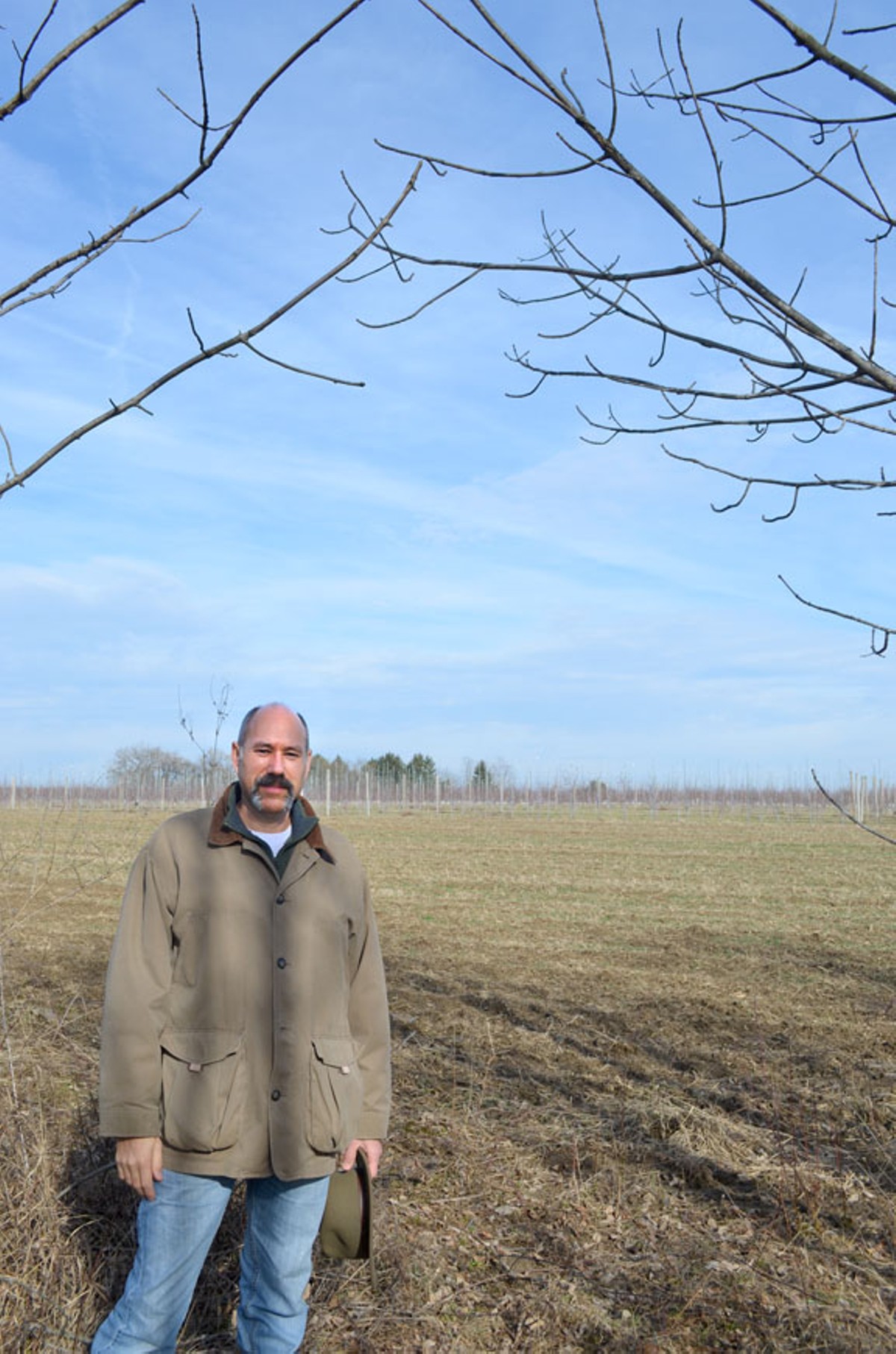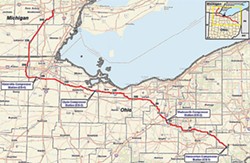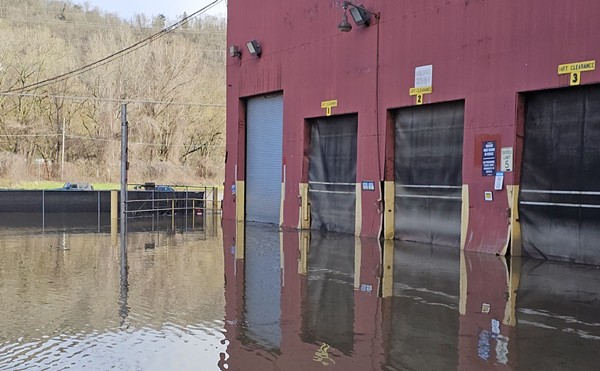A small dozer trundles around the frame of Vic Giaconia's new home in Guilford Township, Ohio. Morning rain left a thick layer of mud on this late February day, and Giaconia arrives to look over the property, praising the construction work and snapping photos of the progress. Contractors set the first beam just last week. "I was pretty excited about that," he says. "It's starting to get there."
Because of the grading on these six acres, there's nowhere else Giaconia could have planted the home's foundation except for the fine crest he's walking on now. To the east, gentle slopes and the early stirrings of cornfields roll toward the horizon in a picturesque snapshot of bucolic Medina County.
"Up until my foundation was in, though, I had no idea what was happening," Giaconia says. "Jon sends me this email, like, 'You gotta call me. Do you have any idea what's going on?'" He's talking about his neighbor, Jon Strong, who lives up on Seville Road and has become, in more than one sense, a trailblazer in Guilford Township's biggest fight ever: the orchestrated opposition to the Nexus natural gas pipeline, which proposes a 255-mile stretch of steel across this and other parts of Ohio, as well as Michigan, en route to its ultimate endpoint in Canada.
"I'm like, 'What are you talking about?'" Giaconia says. "He's talking about Nexus, and I say, 'Yeah, I heard something about this about a year ago, but that's way over there.'
"He's like, 'No, man. It's 150 feet from your bedroom.'"
The two men spoke back in November 2016, shortly after the Federal Energy Regulatory Commission approved the Nexus project's environmental impact and some nine months after Giaconia had purchased his land. Strong brought his new neighbor up to speed. "He had no clue. He was shell-shocked," Strong says.
Giaconia tells Scene that he wasn't told about the proposed pipeline route when he bought the property from its previous owner. The route, as it stands now, cuts through a parcel just north of his own. The so-called blast zone, the area in which people and animals and property would be up against a real safety hazard in the event of a leak or an explosion, is around the 1,500-foot mark. More than 11,000 "pipeline incidents" have happened in the past 20 years in the U.S., according to the Pipeline and Hazardous Materials Administration. But when projects like Nexus get federal certification, there are no recognized safety setback standards to apply. Giaconia quickly started Googling things like "gas leaks U.S."
For now, the Nexus project rests in federal regulatory limbo. It's all but approved by FERC, although currently the agency doesn't have enough commissioners to certify any projects. Nexus, which is owned by Houston-based Spectra Energy and Michigan-based DTE Energy Co., continues to survey private land and offer money for construction access. In the event that those land easements aren't secured between now and a potential final approval, Nexus and FERC have assured property owners that eminent domain will be enforced.
Residents across Ohio and Michigan have not gone quietly. In fact, it's only due to a small band of committed people that this pipeline isn't right now being constructed alongside Giaconia's house.
"It's very frustrating to think that a private industry can come in and do whatever they want if they have enough money and pay off enough people in power," Giaconia says. "I don't even have enough words at this point to talk about my outrage."
***
On a clear day, you can look 100 yards due east from Giaconia's driveway and track the hemline of Jon Strong's wooded property. There, clad in a graying handlebar mustache and wide-brimmed hat, Strong holds court with any neighbors or reporters curious about all this pipeline talk.
Here's the gist: The $2-billion Nexus project would funnel high-pressure natural gas across Ohio and Michigan to the Union Gas Dawn hub in Ontario, Canada.
About 100 miles southeast of Strong's home, the Utica shale play yawns beneath the Ohio-Pennsylvania border. Since 2000, and with the advent of modern horizontal-drilling technology, the Utica has become the hottest natural gas scene outside of North Dakota. The shale play's concentration of rich, wet natural gas is unparalleled, and energy conglomerates are clamoring to drill it and ship its reserves to international export posts, like the Dawn hub.
Combined, the Utica and nearby Marcellus plays coughed up 22.5 billion cubic feet of natural gas per day in 2016. By 2050, estimates by the U.S. Energy Information Administration place that rate at more than 44 billion cubic feet per day. Nexus would add a cool 1.5 billion cubic feet per day to the take.
With the ultimate goal being exports out of Canada, Nexus benefits no Ohio energy customers. It benefits no American customers at all. In fact, the pipeline does nothing but screw with Ohioans' property rights.
"It takes the use of the property out of play for me," Strong says. He's lived here since 1994. "I can't do anything with it then. I can't build on it, I can't put a lake on it. I bought this property for a reason and a purpose, and [Nexus would be] changing it without my consent." He has not allowed any land surveyors onto his property and had not agreed to any offers from Nexus for the 100-foot construction easement they would need to install steel pipe through his property.
Walking along a grassy trail that rings his home, Strong pauses and points east toward Bauman Orchard, which opened in 1919. They grow apples and peaches. In the fall, when Nexus insists that construction will begin, they'll be selling Cortlands and Honeycrisps and tender McIntosh. Bauman has already sold easement rights; the pipeline would drive right through the heart of the orchard — claiming a 100-foot-wide path of land during the build-out — before barreling westward onto Strong's property.
Most of Strong's trees are located right along that route. "This is my sweet spot," Strong says as we reach a bend in the trail. In warmer months, the leafy refuge in his backyard would be replaced with large bulldozers and, later, a 30-inch underground pipeline.
But that day hasn't come yet, because when this whole thing started back in 2014, Strong and number of concerned citizens along the route banded together to form the Coalition to Reroute Nexus, known delightfully as CoRN. Early on, when landmen appeared on front porches and notices showed up in mailboxes, CoRN members rallied and began educating the public as Nexus folks urged quick turnaround on paperwork that would allow them access to land.
As the contractors expressed the urgency of the deal — sweetening their offers toward what one Medina County resident said was a $130-per-foot average — CoRN's leaders and other property owners began organizing meetings and laying out maps and literature for those who hadn't yet learned the full, possible ramifications of Nexus. All along, CoRN stuck to its namesake and planned an alternate route for the pipeline, which they eventually submitted to FERC.
According to court documents filed in 2015, the energy company was insistent — and they remain so: "If NEXUS is unable to access the Properties, the entire permitting and construction timeline likely will be delayed."
It certainly has been.
***
In Medina County, the prosecutor and the sheriff worked alongside Judge Christopher Collier to patiently analyze the pipeline project and draw out the timeline. Tensions were heating up, and Nexus was filing temporary restraining orders against dozens of hold-out residents along the route. Similar court cases unfolded in Summit County, where even more densely populated neighborhoods are contending with Nexus, and in other counties between Northeast Ohio and Canada.
By mid-2015, FERC itself came to Wadsworth and held what it called a "scoping" meeting. Residents from across Summit and Medina counties — and points both east and west — gathered to express concern over the pipeline route. "This pipeline is for profit only. This pipeline does not fit in," Elizabeth Jarrell of Guilford Township said in April of that year. "It is dangerous and disrespectful."
The disrespect has most glaringly been displayed in the lack of communication between Nexus and the people, residents argue. Rather than their own employees, Nexus has sent contracted landmen to acquire easements. Many residents have sold, but others have stood their ground. Property lines became front lines.
Nearby York Township resident Walter Giebeler posted a sign outside his home as tensions increased: "No Trespassing: Due to the High Cost of an Attorney and our Lack of Patience, WE SHOOT TO KILL!" (He was interviewed by WNWO, and he told a reporter, "If it does come down to it, I'll give you a guys a call and you can come.")
As FERC was preparing to grant its approval of Nexus' environmental impact last fall, the land surveying work ramped up in earnest.
Strong posted a video online last November with the title "Nexus Pipeline Survey Intimidation Medina County Ohio." (The video begins with the classic Law and Order: SVU "clang clang" audio.) Strong is seen walking his trail and then zooming in on a group of landmen and Medina County sheriff's deputies walking through the Bauman orchard trees, like apparitions.
"There they are," Strong says in the video. "They're not coming on." The scene is rather surreal; Strong's heavy breathing backdrops the advances of men in uniform, men meaning to take his land.
One of the landmen holds up a clipboard and says, "Just let me go through this."
"I don't really need to hear it," Strong says. "I don't want you to be here, and I'm asking you to leave."
The two men go back and forth a bit — they clearly know each other after all their interactions — and Strong points out that an active civil case in Medina County Court has maintained his freedom to prohibit access to his land.
The video ends with some triumphant, patriotic music and the following quote from President John Adams: "The moment the idea is admitted into society that property is not as sacred as the law of God, and that there is not a force of law and public justice to protect it, anarchy and tyranny commence."
Surveying was supposed to have been finished by the summer of 2015. A long-standing FERC policy statement, clarified in an official statement in 2000, "encouraged project sponsors to acquire as much right-of-way as possible by negotiation with the landowners and explained how successfully doing so influences the Commission's assessment of public benefits and adverse consequences."
That policy, still in effect, demonstrates how closely tied the land surveying work is to the ultimate FERC approval. The more easements Nexus can acquire, the more likely they are to receive certification. It's a perpetual motion machine, and the reason why so many pipeline projects are approved with little scrutiny.
Even if project sponsors aren't able to acquire 100 percent of the easements they need, FERC has assured them that eminent domain will be enforced.
"I understand eminent domain, but that's for the good of the community," Giaconia says. "This is not for the good of any community in this country. This is going to Canada. How do they have the right to take people's property or put lives at risk for something that is happening in a completely different country, you know? It doesn't seem to make sense."
***
Despite all of that — and despite FERC greenlighting the environmental impact of Nexus — the pipeline has yet to receive its actual certificate, the signal to start digging.
On Feb. 3 of this year, Norman Bay resigned as a commissioner of FERC; just prior, President Donald Trump had appointed fellow commissioner Cheryl LaFleur as chair of the agency. (Bay was historically the pro-regulations vote among the body. The scuttlebutt among industry magazines is that Bay wasn't pleased with that latest appointment.) With only two commissioners left now — LaFleur and Colette Honorable — there is no quorum, and voting on pipeline projects has been halted indefinitely. In a flurry of last-minute votes before Bay's resignation, Nexus was lost in the shuffle.
The lack of a decision, though, was hailed as a decision among the opposition. "The lack of action by the Commission can be viewed as confirmation of our position that there is no purpose or need for Nexus," Paul Gierosky, another co-founding member of CoRN and a Medina County resident, wrote in a public statement last month.
In fact, Nexus is just one pipeline project of many that would carry natural gas from the Utica play to out-of-state endpoints. Others include the ET Rover pipeline, the Appalachia to Midwest pipeline, the East-to-West project, the Lebanon Lateral, the Louisiana Access Project; elsewhere in the state, the Oregon Lateral, the Utopia East and the Utopia West help funnel natural gas from Point A to Point B. All told, the projects add up to more than 1,500 miles of steel pipeline carrying more than 22 billion cubic feet of natural gas out of northern Appalachia each day. Much of it ends up in Canada or along the Gulf for export purposes.
There are a lot of reasons why Nexus lost this round of "musical chairs," as Marcellus Drilling News put it. "The only one that had an effective resistance formed to it was the Nexus pipeline, and that was just because of the way it was passing through people's properties," Andrew Smith says. He's been helping CoRN in their organizing efforts in Lorain County, another area along the Nexus route. He points out that groups like CoRN have almost single-handedly brought the project to a seeming halt.
FERC chairperson Cheryl LaFleur said in 2016 that "[P]ipelines are facing unprecedented opposition from local and national groups including environmental activists. These groups are active in every FERC docket, as they should be, as well as in my email inbox seven days a week, in my Twitter feed, at our open meetings demanding to be heard, and literally at our door closing down First Street so FERC won't be able to work. We have a situation here ... I think that our nation is going to have to grapple with our acceptance of gas generation and gas pipelines."
The contrast between LaFleur's public statements, like the one above, and those of former commissioner Norman Bay is stark.
The same day that Bay resigned, he issued a "separate statement" in conjunction with the certificates granted to those pipeline projects. His words scan like an indictment against Nexus in an overcrowded field of Ohio pipeline projects.
"It is in the public interest to foster competition for pipeline capacity but also to ensure that the industry remains a healthy one," Bay wrote, "not subject to costly boom-and-bust cycles. Pipelines are capital intensive and long-lived assets. It is inefficient to build pipelines that may not be needed over the long term and that become stranded assets."
A May 2016 filing with FERC lays out the same case. This is the nut of the whole issue — for property rights advocates, for environmentalists, for proponents of good government.
"We proved they have no customers in Northeast Ohio, and they'll never have customers in Northeast Ohio," Gierosky tells Scene, squaring the point simply. "There's no need for this gas in Northeast Ohio. It's just a sham that they claim that they're taking this route through this market that they've identified. That's window dressing. That goes along with the lies that they've told the public."
Indeed, the only customers they currently have on the books are their own: themselves. DTE Energy in Michigan is a co-sponsor, so they sort of have to buy in. And there's Union Gas, which runs the Dawn hub in Ontario — the same outfit that's intending on exporting American natural gas out of Canada.
Zooming in even further, the pure economics of Nexus aren't working out.
A major problem is that DTE Energy has intended to pass along its costs to Detroit-area customers. The Michigan attorney general has referred to DTE's plan as "improper subsidization." There are presently several cases before the Michigan Public Service Commission in which DTE Energy is seeking guarantees that, should the line not be profitable, it can pass the costs of building Nexus on to DTE rate payers.
As state regulators there fought back against Nexus, DTE increased its commitment to the pipeline "to ensure that the project has sufficient customer commitments to justify proceeding with construction." (DTE said last month that the plan remains to bring the Nexus pipeline "on line" by the end of 2017.)
Rolling onward, TransCanada, Nexus' would-be competitor in Canada, announced its intention just last week to drop its pipeline toll below the 60-cent threshold, in a clear effort to win over shippers in the region. They're concerned about increased pipeline capacity out of the U.S. TransCanada knows how important the Utica play is.
"As soon as you've got incremental pipe out of Appalachia into that region (Ontario), it's another nail in the coffin, and a big nail in the coffin," Ed Kallio, a natural gas analyst with the Eau Claire Energy Advisory, told the Financial Post in late February, speaking about TransCanada's outlook.
If TransCanada can get gas to its customers faster and cheaper with infrastructure that already exists, then what's the point of Nexus?
"That's been the whole argument all along: The longer we can slow this thing down, the more time you leave for things like that to come out of the woodwork that could impact [Nexus]. Every day that goes by there's another variable that influences the pipeline," Strong says. "The whole premise is falling apart."
***
If and when pipeline projects are approved — and they are approved by FERC at a nearly 100-percent rate, historically — residents who live and work along the route must then contend directly with the safety hazards, the threats of leaks or explosions.
"It's not a matter of 'Could there be a problem?' Yeah, there could be a problem," Giaconia says, scanning his property line from atop a low hill on his land. "We've got a documented history of problems. There's high likelihood that there could be a problem. Does it happen right here? I don't know. But it could."
According to data compiled by the Pipeline and Hazardous Materials Administration (part of the federal Department of Transportation), from 1997 to 2016 there were 11,460 reported "pipeline incidents" in the U.S., accounting for 324 deaths and 1,331 injuries.
All told, the incidents brought some $7 billion in property damage.
In 2014, for instance, the Tennessee Gas Pipeline Co. reported 92 "significant incidences" clocking in at $88.1 million in property damage across the Appalachian region. As PHMA looked closer, the organization later found out that Tennessee Gas hadn't reported an additional 45 incidences and $110 million in damage.
In April 2016, a natural gas pipeline exploded in Westmoreland County, Pennsylvania, just outside Pittsburgh. The pipeline was part of Spectra Energy's sprawling Penn-Jersey System, which ships gas from the Marcellus play to the coast. News reports of the rupture noted a "fireball soaring hundreds of feet into the air." Multiple buildings were impacted, and one man, James Baker, was severely injured. His home was 500 feet from the pipeline.
Spectra cited accelerated corrosion as the cause of the rupture. A spokesperson at the time mentioned a 2012 report that provided actual evidence of corrosion, but said that it did not meet a threshold that would have warranted investigation.
Indeed, FERC has no safety setback standards, and the oil and gas companies that lobby and help set energy production policy tend not to hold themselves to rigorous scrutiny.
"I don't see how that's not taught. I don't see how that's not spoken about," Smith says. "I don't see how there's not a plan at the federal level to actually make a change."
Safety hazards aren't simply confined to explosions, either. The Nexus pipeline — and others in Ohio — would cross streams, rivers, lakes, wetlands, migratory bird routes, endangered species' habitats, fault lines and other areas that are rather important to animal health.
Strong points up toward his trees and says that, across southern Medina County, a species of long-eared bats make their homes here. That's a threatened species, to be sure, according to the U.S. Fish and Wildlife Service, which shades pipeline construction with a tighter set of regulations. For one, the habitats of threatened species — in this case, the trees along portions of the Nexus route — may not be cut down between April 1 and Sept. 30. For a company that's highly interested in cutting down trees in order to install a steel pipeline, that's a major problem at the moment, here in early March. The window is closing.
***
It's March 2017, and not an ounce of dirt has been displaced in the name of Nexus. According to the original timeline, construction should have already been happening. Now the company insists that construction will be under way by the fall.
It hangs between words when homeowners along the route talk about their properties, about their goals and plans in life.
"One of the nice things I liked about this property is that it had some trees," Giaconia says. "As it is, they'd be wiping out all those trees through that area." He believes that, in the event this pipeline moves closer to reality, there's some room for negotiations to get his house outside the potential blast zone of the route. Soon after he learned everything last fall, Giaconia filed a formal statement with FERC. He has yet to receive a response.
It's not for nothing that CoRN members and other parties along the route have pointed to the Standing Rock protests against the Dakota Access pipeline as an example of what can happen when enough Davids shout down a Goliath. If it's not you today, maybe it's you tomorrow, more than one Nexus opponent told Scene.
If nothing else, Standing Rock shows how strength does blossom in numbers and in public awareness. At the height of the mainstream media attention, the Army Corps of Engineers relented and ordered a further review of the pipeline route in North Dakota. (The Army Corps has since granted the final easement for the pipeline, and, on Feb. 22, law enforcement kicked protesters out of the camps they had set up on federal land.)
"Through the court of public opinion," Gierosky says, "they were able to get the attention of the pipeline company." Every victory matters. The attention on North Dakota has helped the fight in Ohio and in Michigan.
The tension remains present along the Nexus route, especially in the wake of Bay's resignation and up against a fever-pitch pipeline-loving energy industry and a president who's signaled his support. There's still reason to fight, Strong says. And it's hard to ignore the underlying point in all of this: Had he and his neighbors not spoken up in the first place, "They'd have been digging already — guaranteed," Strong says. "Time is our friend and their foe."
This story has a companion piece in our sister paper, the Metro Times. It can be found at metrotimes.com/















